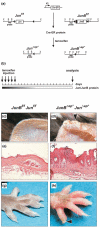Activator protein 1 (Fos/Jun) functions in inflammatory bone and skin disease
- PMID: 18226189
- PMCID: PMC2374460
- DOI: 10.1186/ar2338
Activator protein 1 (Fos/Jun) functions in inflammatory bone and skin disease
Abstract
Activator protein 1 (AP-1) (Fos/Jun) is a transcriptional regulator composed of members of the Fos and Jun families of DNA binding proteins. The functions of AP-1 were initially studied in mouse development as well as in the whole organism through conventional transgenic approaches, but also by gene targeting using knockout strategies. The importance of AP-1 proteins in disease pathways including the inflammatory response became fully apparent through conditional mutagenesis in mice, in particular when employing gene inactivation in a tissue-specific and inducible fashion. Besides the well-documented roles of Fos and Jun proteins in oncogenesis, where these genes can function both as tumor promoters or tumor suppressors, AP-1 proteins are being recognized as regulators of bone and immune cells, a research area termed osteoimmunology. In the present article, we review recent data regarding the functions of AP-1 as a regulator of cytokine expression and an important modulator in inflammatory diseases such as rheumatoid arthritis, psoriasis and psoriatic arthritis. These new data provide a better molecular understanding of disease pathways and should pave the road for the discovery of new targets for therapeutic applications.
Figures




References
-
- Riera-Sans L, Behrens A. Regulation of alphabeta/gammadelta T cell development by the activator protein 1 transcription factor c-Jun. J Immunol. 2007;178:5690–5700. - PubMed
Publication types
MeSH terms
Substances
LinkOut - more resources
Full Text Sources
Other Literature Sources
Medical
Research Materials
Miscellaneous

